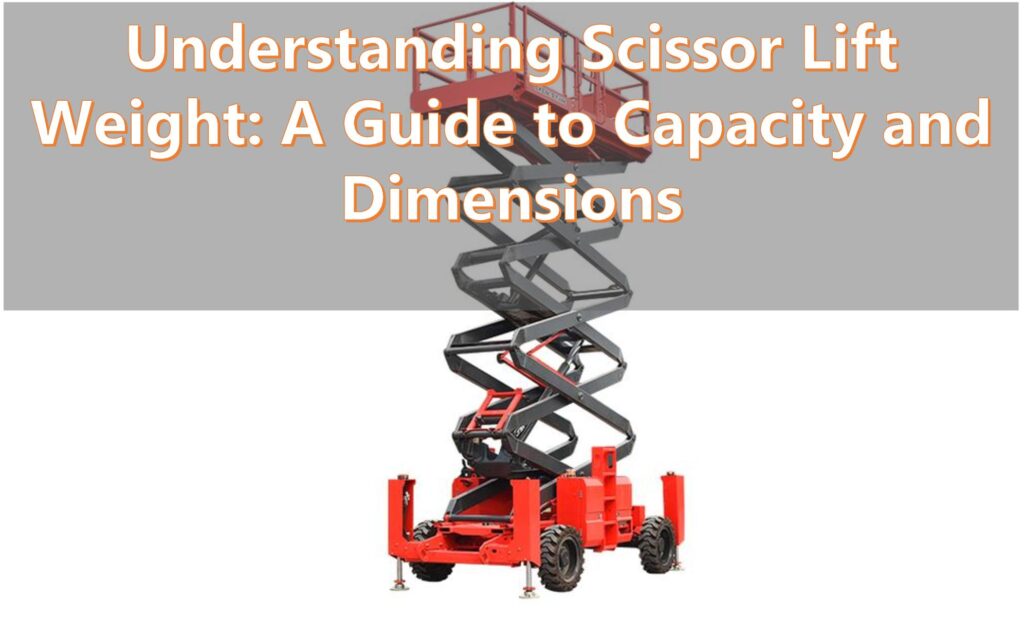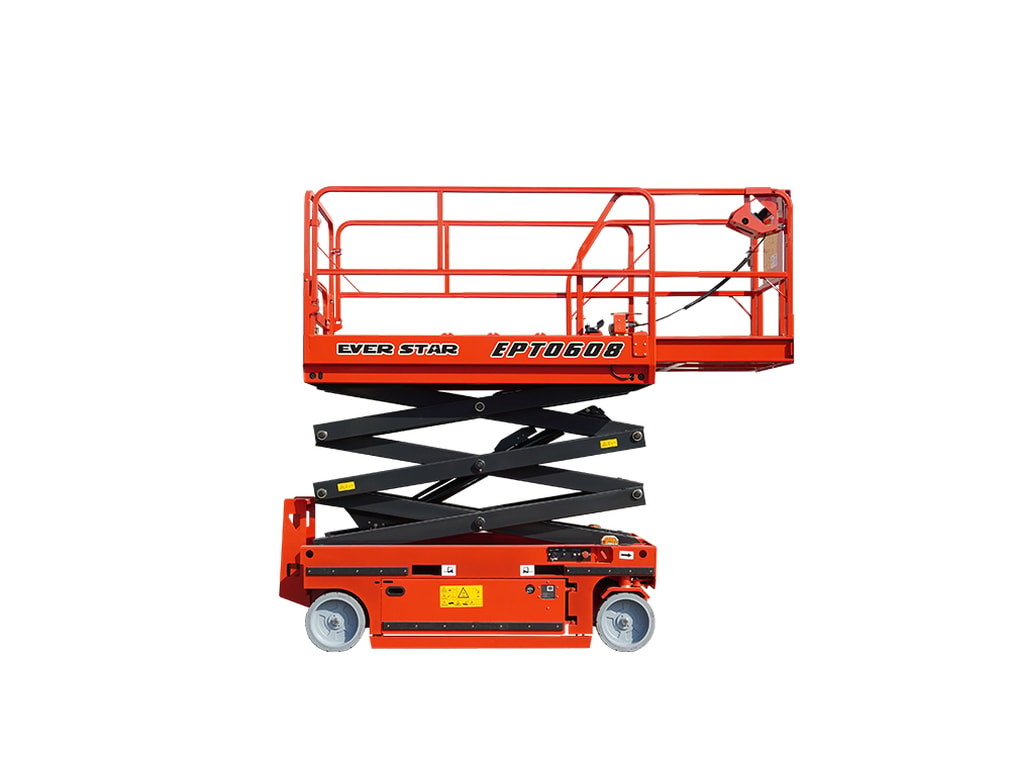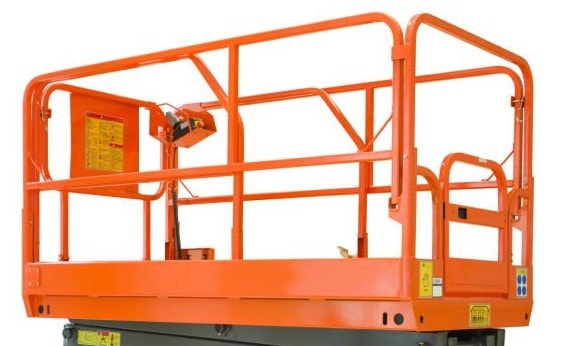
What equipment comes to mind when you want to reach an elevated height in a project? For many users, the scissor lift ranks highly for its incredible versatility.
Now, when you are looking to buy or rent a scissor lift, there is a critical consideration to make: How much does a scissor lift weigh? The team at Everstar® thoroughly addresses this concern before selling any of their state-of-the-art scissor lifts.
As we introduce you to the amazing scissor lift models at Everstar®, we will provide a deep analysis of the weight considerations for the scissor lift in work environments, whether for indoor or outdoor use.
How much does a scissor lift weigh?
A scissor’s lift weight is the gravitational force that the equipment exerts because of its mass. It is how heavy or light the lift is. It is an important factor because it determines the stability, mobility, ergonomics, and general functionality of the scissor lift.
How can you know a scissor lift weight rating and weight? There are three main approaches to determining this element. First, check the manufacturer’s specifications. The manufacturer will often include this crucial information in the packaging.
Another way is to compare the scissor lift with other items of the same category. This method is applicable for reputable manufacturers like Everstar® who adhere to machine weight standards.
If these approaches do not work, you may have to access the product and weigh it.
Factors Influencing Scissor Lift Weight
The size of the scissor lift model
The first determinant of the weight of the scissor lift is the size. Whether the height capacity or the platform size, a bigger size means more construction materials are used and more weight. If the workers need to carry this equipment with them, ensure you find a balance between the size and manageable weight.
The Construction Materials
Globally, the ideal and most popular material for scissor lifts is Q345 steel. The low alloy steel material is also common in bridges, pressure vessels, and ships. All these applications require a significantly strong material, a property that Q345 steel meets. The Q in the name denotes the material’s yield strength while 345 is the material’s yield strength of 345 MPa.
If not this first-choice material, the manufacturer may opt to use other materials such as high-strength stainless steels and steel alloys. Aluminum alloys such as 7075-T6 and 6061-T6 may be considered for lightweight scissor lifts with minimal load capacity.
The point is, the manufacturer must make a compromise between the material type and weight limit. For instance, aluminum alloys have lower densities and lightweight, so they make transportation easier. However, they are deficient in durability, hardness, and tensile strength compared to Q345 steel.
Types of Scissor Lifts and Their Typical Weights
Scissor lifts have a general standard design characterized by a scissor mechanism.

However, these aerial lifts have varied weights and this forms the categorization of the equipment. Whatever the model, the typical lift weight ranges between 545 kg. and 7,700 kg. The three main weight ranges are small, medium, and large.
Small scissor lifts
Scissor lifts in this category typically weigh between 545 to 1,100 kg. These aerial lifts have lower weight capacity and floor load pressures. Most of them come with an electric power source, meaning you can use them indoors because they produce no emissions.

The advantages of these scissor lifts include low noise, higher portability, and suitability for tight spaces. Use these types on even terrains where height requirements are minimal. They are suitable where the work should be completed in a short time.
Medium scissor lifts
The weight limit for these ones usually ranges from 1,100 to 2,300 kg. Models in this category are slightly heavier than the small ones. The biggest advantage of medium scissor lift models is the versatility of being suitable for indoor or outdoor use. Their working height and platform capacity are higher than the previous category.
Large scissor lifts
Any lift that weighs more than 2,300 kg belongs to this class. This is where you will find all the heavy-duty models that can work on any terrain. With their solid build, the scissor lifts with this kind of weight need more than an electric power source.
Most of them are gas-powered so they can provide longer runtime. Larger scissor lifts have larger platform capacity and height due to the higher machine width. Therefore, they can support more personnel. Such capacity is only suitable for outdoor use.
Everstar® is home to different sizes of scissor lifts, including the Off-road series two-way unfolding platform scissor lift that is one of the best rough terrain rough terrain scissor lifts.

Get a glimpse of the various sizes of scissor lifts available at and ask for an instant quote.
Scissor Lift Dimensions and Height Capacities
As seen above, scissor lifts are available in different weight capacities. The smallest machines are expected to weigh the lowest, and vice versa. Similarly, there are various scissor lift heights and dimensions, elements that could determine the most suitable type of scissor lift for your project requirements.
By most industry standards, the working height of scissor lifts starts at 10 feet. These are usually the basic electric scissor lift models. At the other extreme are the lifts powered by diesel engines that can reach platform height of over 70 feet.
Let’s look at the sub-categories according to platform height capacity below:
10-15 Foot Height Models
Scissor lifts in this height category are ideal for indoor jobs and tight spaces. The bulk of these machines are electric models, implying they won’t clog indoor spaces with toxic fumes. These models are ideal for warehouses and construction tasks where the lifting capacity is around 230 kg.

20-foot lift height models
Next up are these models that are also preferable for maneuvering through narrow aisles and indoor areas. They typically have platform capacity for only a few operators.
Many are electric models and use special tires that leave floors intact. You will like lifts in this category for their effectiveness in trimming trees and maintaining roofs of buildings with a few stories.
25-foot lift height models
Upgrade to models with this height capacity if your projects revolve around cleaning windows for buildings, doing repair works from the outside, and so forth. The machines are suitable for any task that goes to around three stories. Depending on the platform size, this machine can accommodate two workers.
30-foot lift models
For even more flexibility, consider the 30-foot scissor lift models. These machines are equipped with sturdier tires and frames for added weight capacity. They offer higher flexibility that goes with the uncertainty of outdoor use. Users in maintenance projects are fond of this type of scissor lift.

50-70-foot lift models
Finally, it is this height category of the tallest scissor lifts. It has the highest lifting capacity because the platform capacity allows for several operators. The kind of work the operators do using these machines means that they spend a lot of time aboveground – building exteriors, repairing power lines, brickwork, and so on.
Implications of Scissor Lift Weight
When choosing a scissor lift, this is an important question: How much does a scissor lift weigh? That’s because the equipment’s weight has dire effects on several things. For example, if you use a large scissor lift that is at least 2,300 kg heavy indoors, you will realize that it can easily damage sensitive flooring.
Consider the following factors that depend on the weight of the scissor lift:
Logistics
Moving a scissor lift from one point to another can be challenging. That is especially true for the larger equipment used in outdoor applications. If you want to move the equipment from job site A to B and it is heavy with a large platform capacity, the movement alone can be very expensive.
You must consider this aspect to be able to manage the costs and time for moving the item for your various projects.
Load Capacity
The load capacity is an important factor that depends on the weight of the scissor lift. The larger, heavier scissor lifts tend to have more load capacity than the smaller ones. These machines can occupy larger spaces. This has a direct effect on the versatility of the equipment because it allows for application in a wide range of work environments.
The Number of Personnel
A lightweight scissor lift model or a medium-weight one may only be able to carry a few workers. If you need more personnel on the equipment, go for a larger-sized and heavier scissor lift.

Maintenance Considerations for Scissor Lifts
Scissor lift maintenance is critical to prevent accidents such as the collapse of the lifting mechanism due to excess weight. Users must prioritize maintenance, whether the machine is owned or rented. There are several general approaches to quality scissor lift maintenance.
Regular Inspections
Regular inspection is the core of scissor lift maintenance. It entails routinely checking components and systems such as scissor arms, hydraulic pistons, the control system, and lighting. Some inspections should be done daily before the equipment is used. For instance, the operator should always check the fuel level, hydraulic fluid level, connections for leaks, and tire condition.

Scissor lifts from Everstar are robust and built using the highest quality materials for durable performance. The access panels are also easy to facilitate routine checks of the critical systems such as engine oil and hydraulic fluid.
Cleaning and Lubrication
The moving parts of the scissor aerial lifts are prone to wear and tear, so they require regular lubrication. It is also crucial to clean the machine thoroughly after use, especially if the working conditions are harsh. Cleaning helps keep the machine free of debris, dust, and dampness that could enhance deterioration.
The protective coatings and rust resistance finishes on Everstar® scissor machines are a big asset. Only simple cleaning is required even in harsh outdoor job sites. No matter the environment, our scissor lifts are designed to offer years of flawless performance.
Consulting the Manufacturer’s Manual
Scissor lifts come with user guidelines outlining the recommended maintenance procedures among other usage guidelines. You are guaranteed optimal performance of the machine if you adhere to these official guidelines.
Our lightweight scissor lifts have comprehensive user manuals with handy guidelines and tips. They have crucial information about the safe use of the machine. You can find important maintenance-related information in the guides, for instance, how to ensure the weight is well distributed across the machine for safety and durability.
Know the Limits of the Scissor Lift
Many users get it wrong regarding the weight capacity of the scissor lift and constantly overload it. Fast deterioration follows, preceded by expensive repairs. Whether you use the aerial lift in the factory or construction sites, always ensure adherence to weight and platform capacity limits.

A lot of damage happens due to improper use including structural failure, scissor mechanism failure, and hydraulic system issues. All these lead to a lower life expectancy of the machine, particularly for lifts regularly used on rough terrain.
Provided you use them as stipulated in the user’s manual, Everstar® scissor lifts will always deliver even in highly demanding conditions. Their sturdy construction and well-thought-out designs prove our commitment to safe weight capacity. The lifts also have special features that offer added restrictions in case of subconscious overloading.
Choosing the Right Scissor Lift for Your Project
So, are you considering a scissor lift for your next project? When the options are so many with considerations for weight capacity, height, and fuel, among other factors, it is easy to be confused. You want to choose the right equipment for effective and safe completion of the job.
Apart from the scissor lift weight factor, you need to ask yourself questions about the working height, vertical reach, load capacity, and the terrain of the working environment.
What is max working height on a scissor lift?
Can my truck carry the lift?
How much does a scissor lift weigh?
Do I need a machine that can work on uneven surfaces?
The answers to such questions determine the tire type, drive type, and general design of the scissor lift.
Other factors that can guide the selection process include:
- The mobility of the platform
- The amount of space available
- The type of power source available
- The budget for the equipment
Conclusion
In this guide, we have answered varied questions about scissor lift weight rating and weight. What comes out is that there is no one-size-fits-all kind of scenario when it comes to the ideal weight limit for scissor lifts. A machine that works for one project may not be suitable for another.
For scissor lift options of diverse weights to suit your project, you can count on the products by Everstar®. There are no hidden details in our product specs and our prices are very competitive. Our team will ensure you understand all the weight-related matters before you can invest in our aerial lifts.
As discussed, the size and type of scissor lift are the biggest determinants of the maximum weight of the machine. We encourage you to start by identifying your project requirements. Combining those details with the tips shared here, paring down your selection, and finding the right scissor lift weight should be simple.
Would you like to discuss more details about scissor lift weight and probably get a quality man lift at a great price? We are ready to help. Contact us at Everstar® today for more insights.
FAQs
How much does a scissor lift weigh?
The weight of a scissor lift varies depending on factors such as weight capacity, platform capacity, material composition, and type of power source. Generally, the weight range for most scissor lifts is between 500kg and 10,000kg.
What is the weight rating of a scissor lift?
The weight rating of a scissor lift is the total weight the machine can support on its platform. This comprises weights for tools, personnel, and supplies. If there is an extension deck on the platform, its weight would also be included in the weight rating.
What is the maximum working height on a scissor lift?
The maximum working height on a scissor lift is the highest vertical distance it can reach for safe use by the operator. This height is measured from the ground to the platform height and added to the average reach of an operator from the platform height. This reach is normally approximately 6 feet.
What is a small scissor lift?
A small scissor lift is a model that is at the lowest weight and height category, which is usually reserved for simpler indoor applications. It is not built for rough terrain, but rather the simpler work environments such as warehouse tasks and factory maintenance. The frame can fit the common spaces and the platform capacity and weight capacity are in the lower category.
Why is it important to know the weight of a scissor lift?
It is important to know the weight of a scissor lift because it affects the functionality, safety, and general cost-effectiveness of the machine.